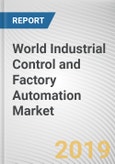Adoption of IOT and advancement in M2M communication technology are factors propelling the growth of the industrial control and factory automation market. However, lack of skilled professionals and requirement of high investment to shift from traditional manufacturing to smart manufacturing are factors restraining the growth of the market. On the other hand, industrial revolution 4.0 would create opportunities in the market.
The industrial control and factory automation market is segmented into technology, component, industry, and geography. The technology segment is further classified into SCADA, PLC & RTU, DCS, MES, HMI, and safety. The components covered in the market are industrial robot, machine vision, valve, control device, and field instrument. On the basis of industry, the market is classified into discrete and process industry. Geographically, the market is segmented based on North America, South America, Europe, Asia-Pacific, and Latin America, Middle East and Africa (LAMEA).
The prominent companies operating in the market are Siemens AG, Rockwell Automation, ABB Ltd., Schneider Electric, General Electric, Emerson Electric Corporation, Honeywell International Inc., Mitsubishi Electric, Yokogawa, and Johnson Controls. They have adopted strategies, such as mergers & acquisitions, partnerships, collaborations, expansions, new product launches, joint ventures, agreements, and others to strengthen their position in the market.
KEY BENEFITS FOR STAKEHOLDERS:
The report offers a detailed analysis of key driving and restraining factors of the world industrial control and factory automation market.
This report offers an in-depth quantitative analysis of the current market and estimations through 2015 and 2020, which assists in identifying the prevailing market opportunities.
An exhaustive analysis of key strategies adopted by leading manufacturers helps in understanding competitive scenario.
The report provides an extensive analysis of current and future market status of the world industrial control and factory automation market.
Comprehensive analysis has been done in this report by constructing market estimations for the key market segments between 2015 and 2020.
An extensive analysis of current research and clinical developments within the world industrial control and factory automation market is provided with key market dynamic factors that help in understanding the behavior of the market.
The world industrial control and factory automation market is segmented into North America, South America, Asia-Pacific, Europe, and Latin America, Middle East and Africa (LAMEA).
KEY MARKET SEGMENTS:
By Technology
SCADA
PLC & RTU
DCS
MES
HMI
Safety
By Component
Industrial Robot
Machine Vision
Valve
Control Device
Field Instrument
By Industry
Discrete
Process
By Geography
North America
South America
Asia-Pacific
Europe
Latin America, Middle East and Africa (LAMEA)
KEY MARKET PLAYERS:
Siemens AG
Rockwell Automation
ABB Ltd.
Schneider Electric
General Electric
Emerson Electric Corporation
Honeywell International Inc.
Mitsubishi Electric
Yokogawa
Johnson Controls
Methodology
The analyst offers exhaustive research and analysis based on a wide variety of factual inputs, which largely include interviews with industry participants, reliable statistics, and regional intelligence. The in-house industry experts play an instrumental role in designing analytic tools and models, tailored to the requirements of a particular industry segment. The primary research efforts include reaching out participants through mail, tele-conversations, referrals, professional networks, and face-to-face interactions.
They are also in professional corporate relations with various companies that allow them greater flexibility for reaching out to industry participants and commentators for interviews and discussions.
They also refer to a broad array of industry sources for their secondary research, which typically include; however, not limited to:
- Company SEC filings, annual reports, company websites, broker & financial reports, and investor presentations for competitive scenario and shape of the industry
- Scientific and technical writings for product information and related preemptions
- Regional government and statistical databases for macro analysis
- Authentic news articles and other related releases for market evaluation
- Internal and external proprietary databases, key market indicators, and relevant press releases for market estimates and forecast
Furthermore, the accuracy of the data will be analyzed and validated by conducting additional primaries with various industry experts and KOLs. They also provide robust post-sales support to clients.

LOADING...








